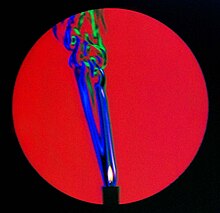Schlieren

Schlieren (from German; singular "Schliere") are optical inhomogeneities in transparent material not visible to the human eye. Schlieren physics developed out of the need to produce high-quality lenses void of these inhomogeneities. These inhomogeneities are localized differences in optical path length that cause light deviation. This light deviation is converted to shadow in a schlieren system.
History
Schlieren were first observed by Robert Hooke[1] in 1665 using a large convex lens and two candles. One candle served as a light source. The warm air rising from the second candle provided the schliere. The conventional schlieren system is credited mostly to German physicist August Toepler. Toepler's original system [2] was designed to detect schlieren in glass used to make lenses. In the conventional schlieren system [3], a point source is used to illuminate the test section containing the schliere. An image of this light is formed using a converging lens (also called a schlieren lens). This image is located at the conjugate distance to the lens according to the thin lens equation: where is the focal length of the lens, is the distance from the object to the lens and is the distance from the image of the object to the lens. A knife edge at the point source-image location is positioned as to partially block some light from reaching the viewing screen. The illumination of the image is reduced uniformly. A second lens is used to image the test section to the viewing screen. The viewing screen is located a conjugate distance from the plane of the schliere.
Schlieren Flow Visualization
Schlieren flow visualization is based on the deflection of light by a refractive index gradient[4] The index gradient is directly related to flow density gradient. The deflected light is compared to undeflected light at a viewing screen. The undisturbed light is partially blocked by a knife edge. The light that is deflected toward or away from the knife edge produces a shadow pattern depending upon whether it was previously blocked or unblocked. This shadow pattern is a light-intensity representation of the expansions (low density regions) and compressions (high density regions) which characterize flow.
See also
- Mach-Zehnder interferometer
- Schlieren photography
- Shadowgraph
- Background Oriented Schlieren technique
References
- ^ Hooke, R., "Of a New Property in the Air," Micrographia, Observation LVIII,217-219, London(1665).
- ^ Toepler, A., Beobachtungen nach einer neuen optischen Methode, Maximillan Cohen und Sohn, Bonn (1864).
- ^ Rienitz, J., "Schlieren Experiments 300 years ago," Nature[London] 254, 293-295 (March 27, 1975).
- ^ Settles, G. S., Schlieren and shadowgraph techniques: Visualizing phenomena in transparent media, Berlin:Springer-Verlag, 2001.
External links
- Non-intrusive optical diagnostic experiments for high-speed flow generator flowfield characterization
- Flow Visualization System for a Pulse Detonation Engine
- The Penn State University Gas Dynamics Lab
- Background Oriented schlieren for flow visualisation in hypersonic impulse facilities
- Visualisation of supersonic flows in shock tunnels using Background Oriented Schlieren (BOS) technique
- Video on Schlieren photographs




